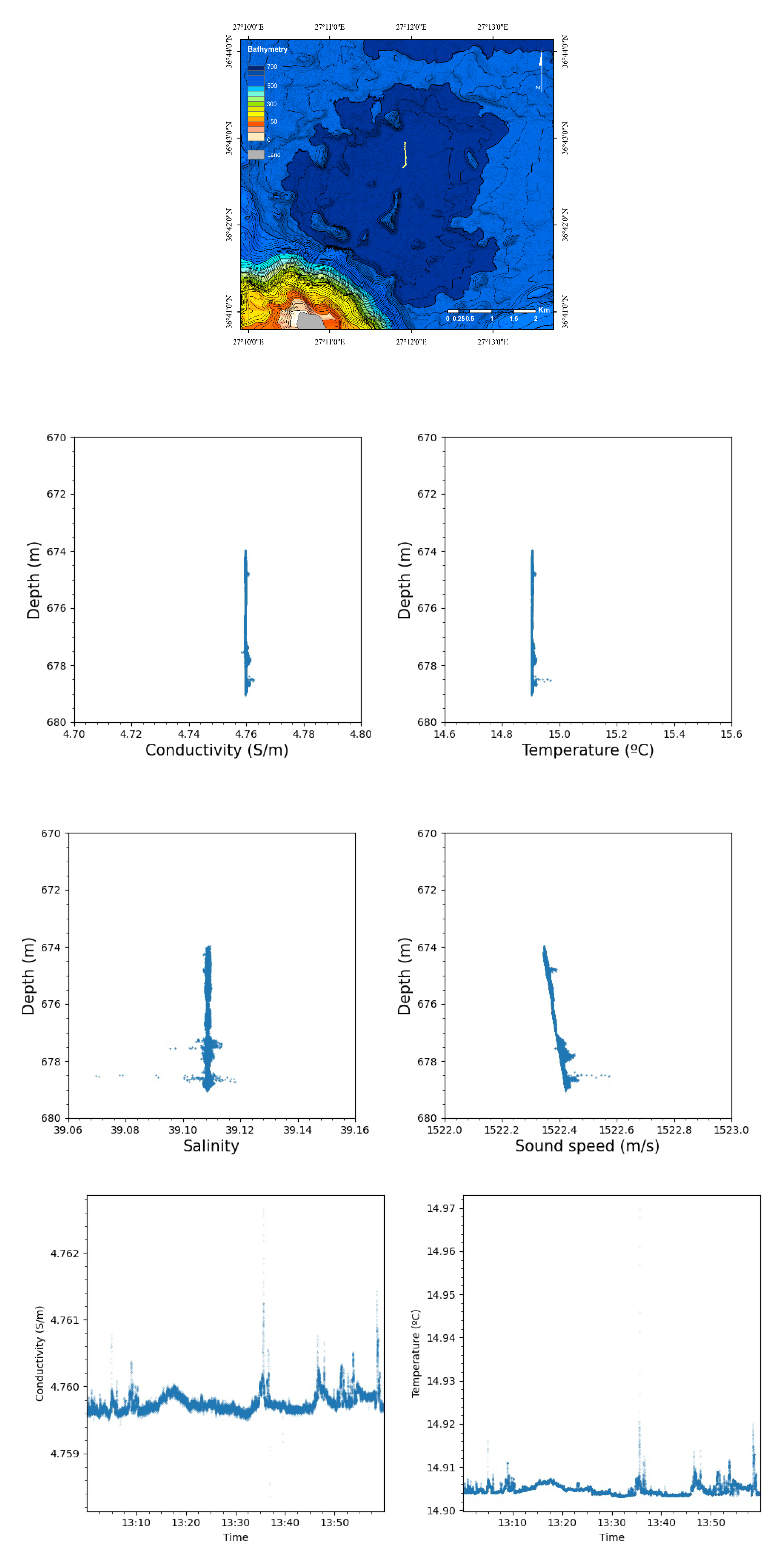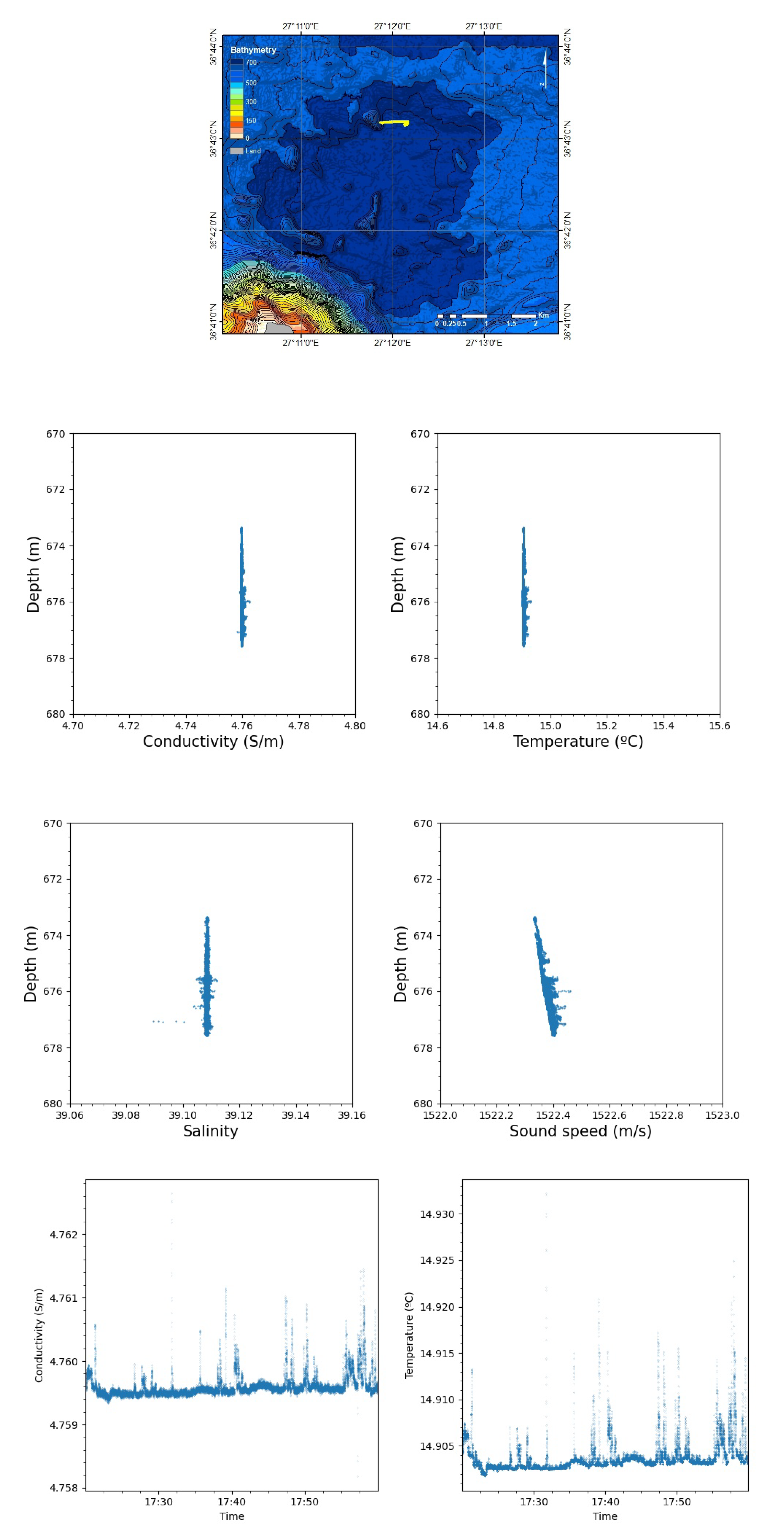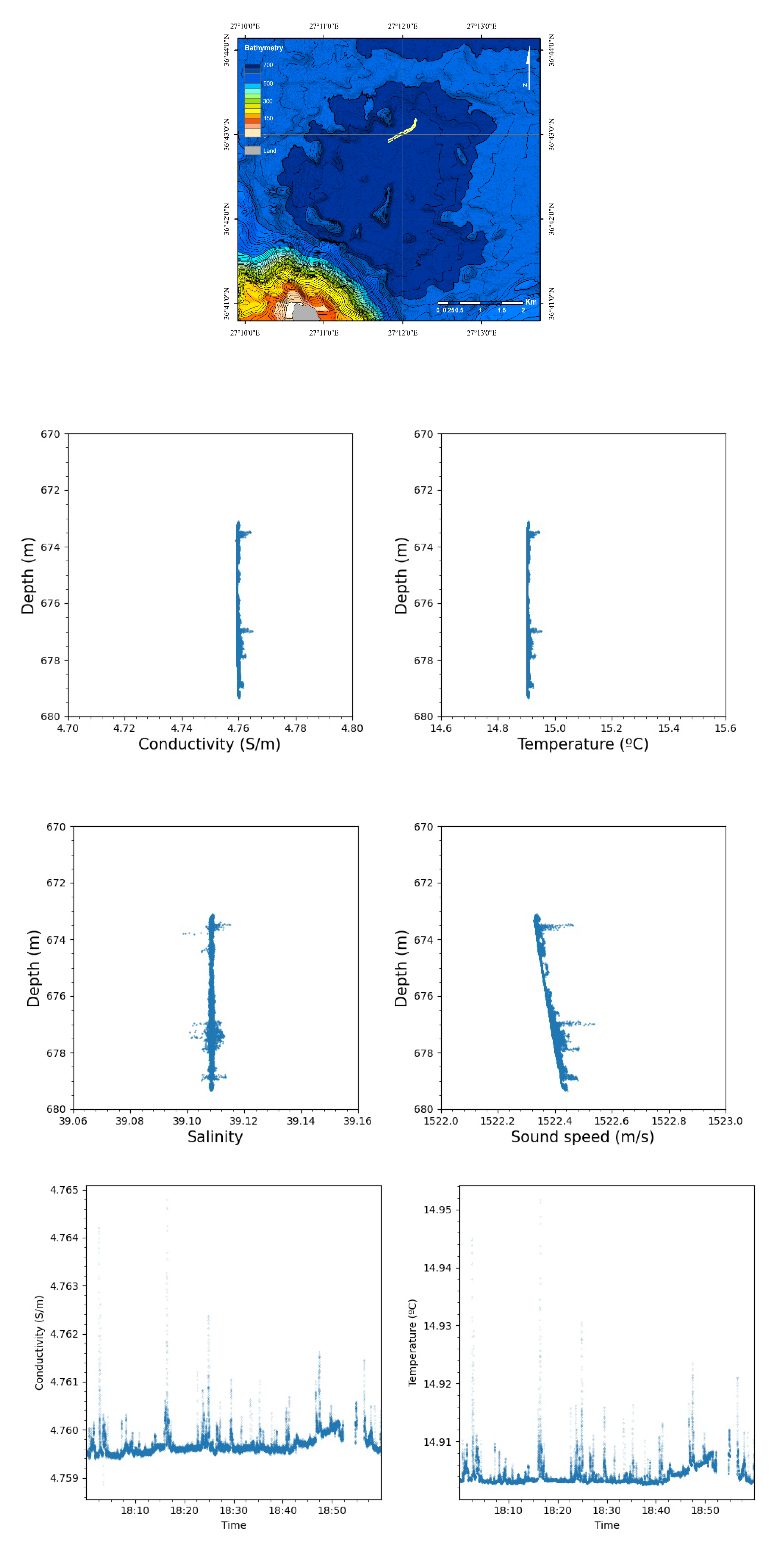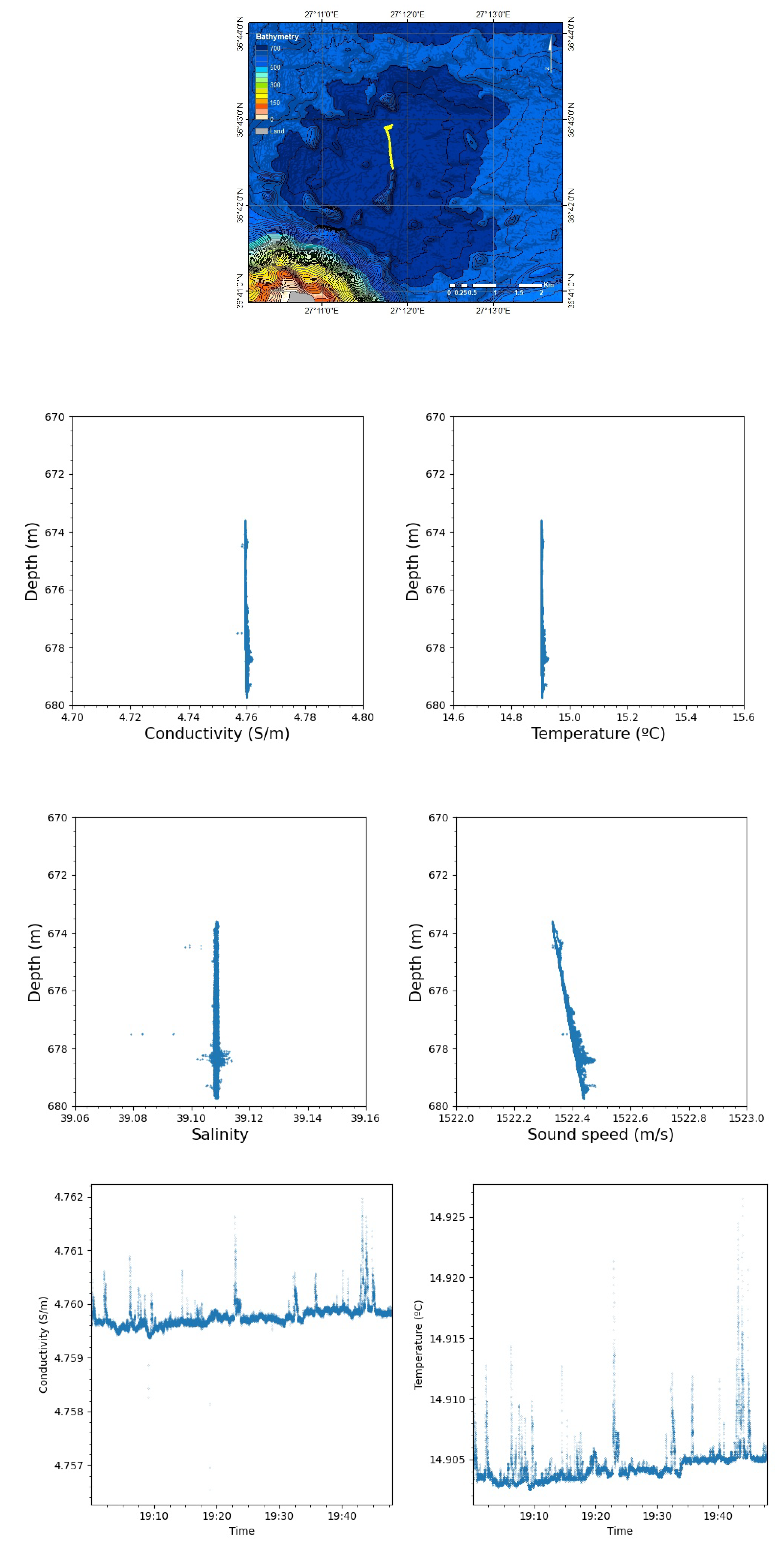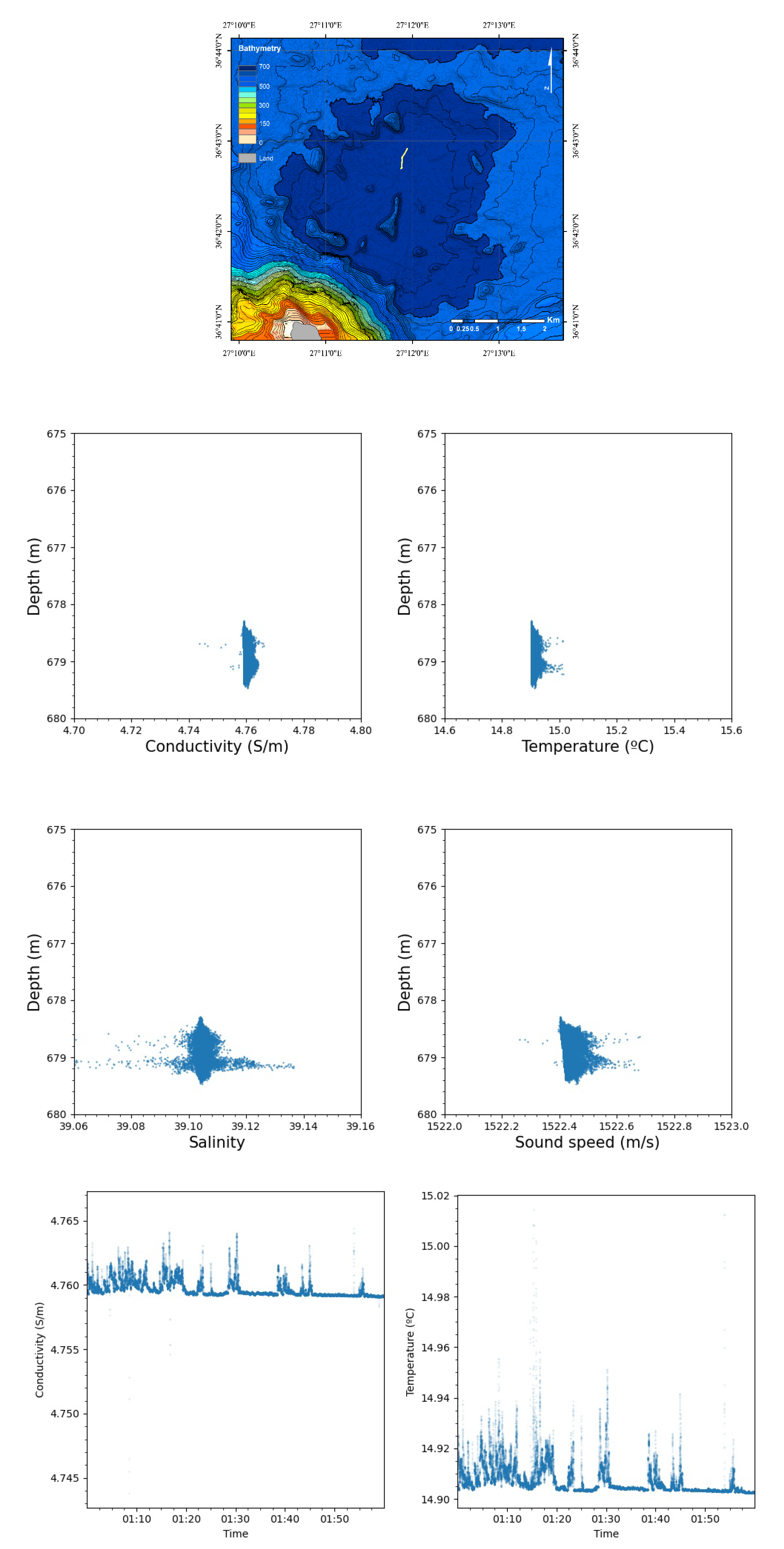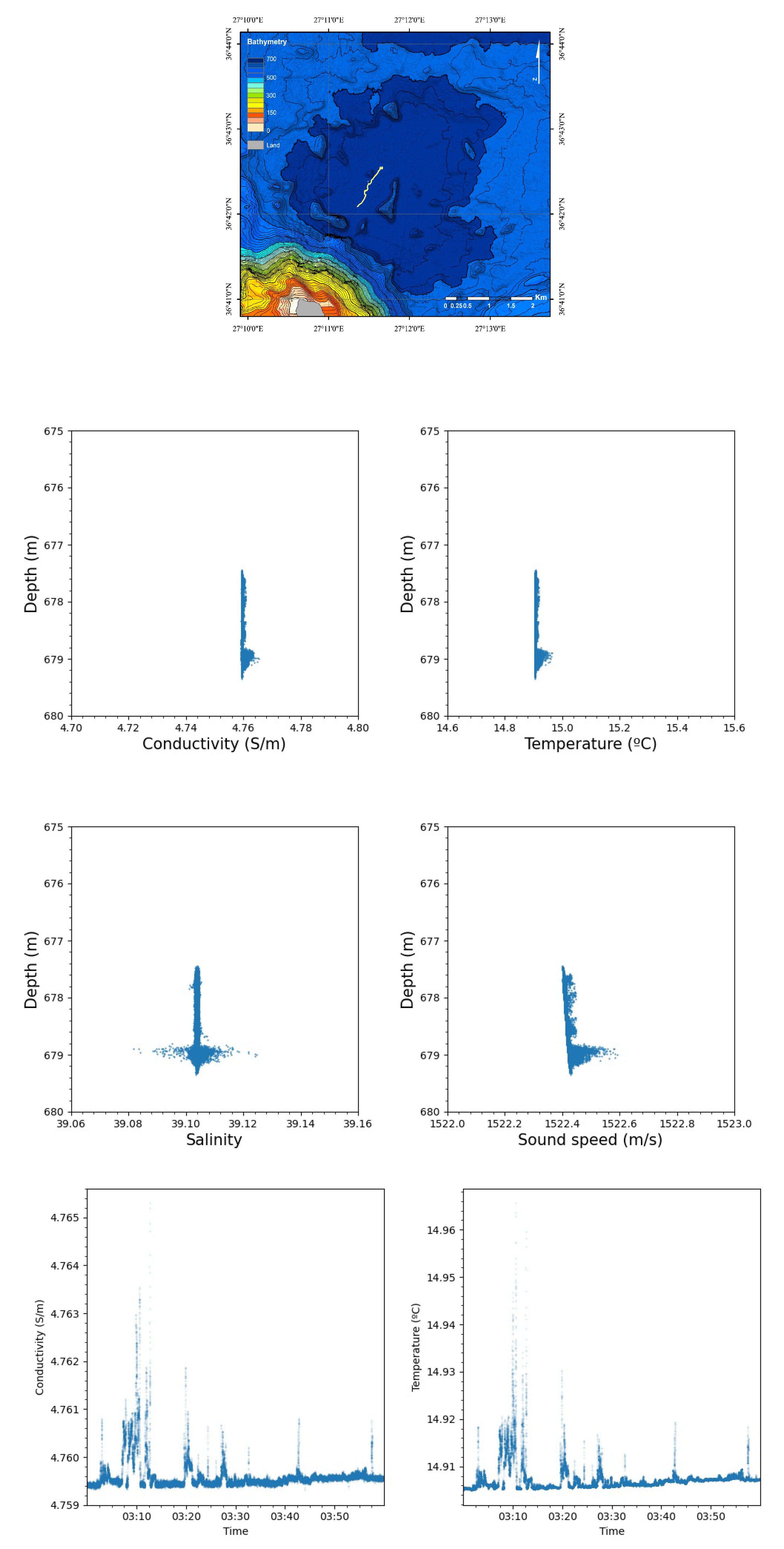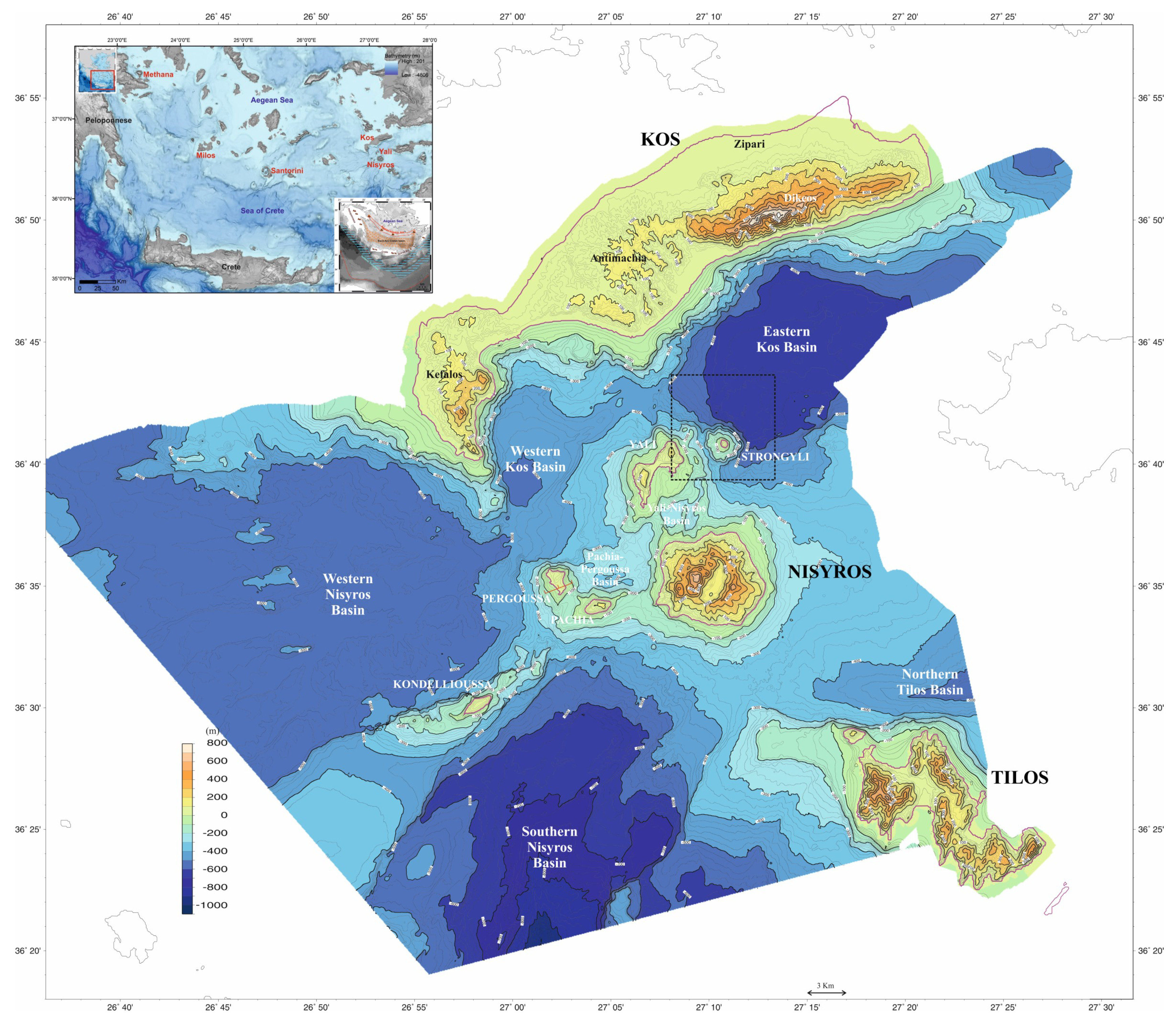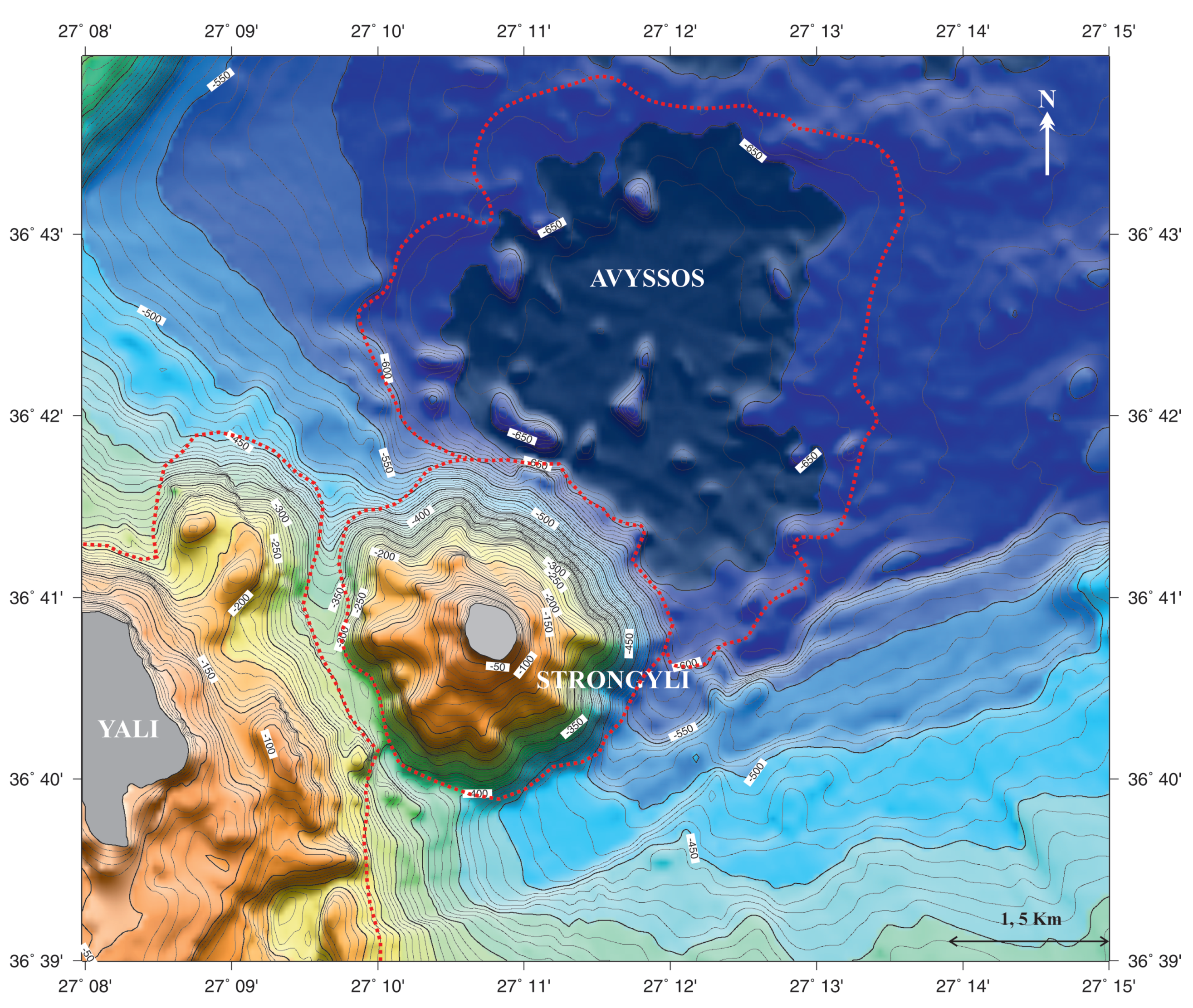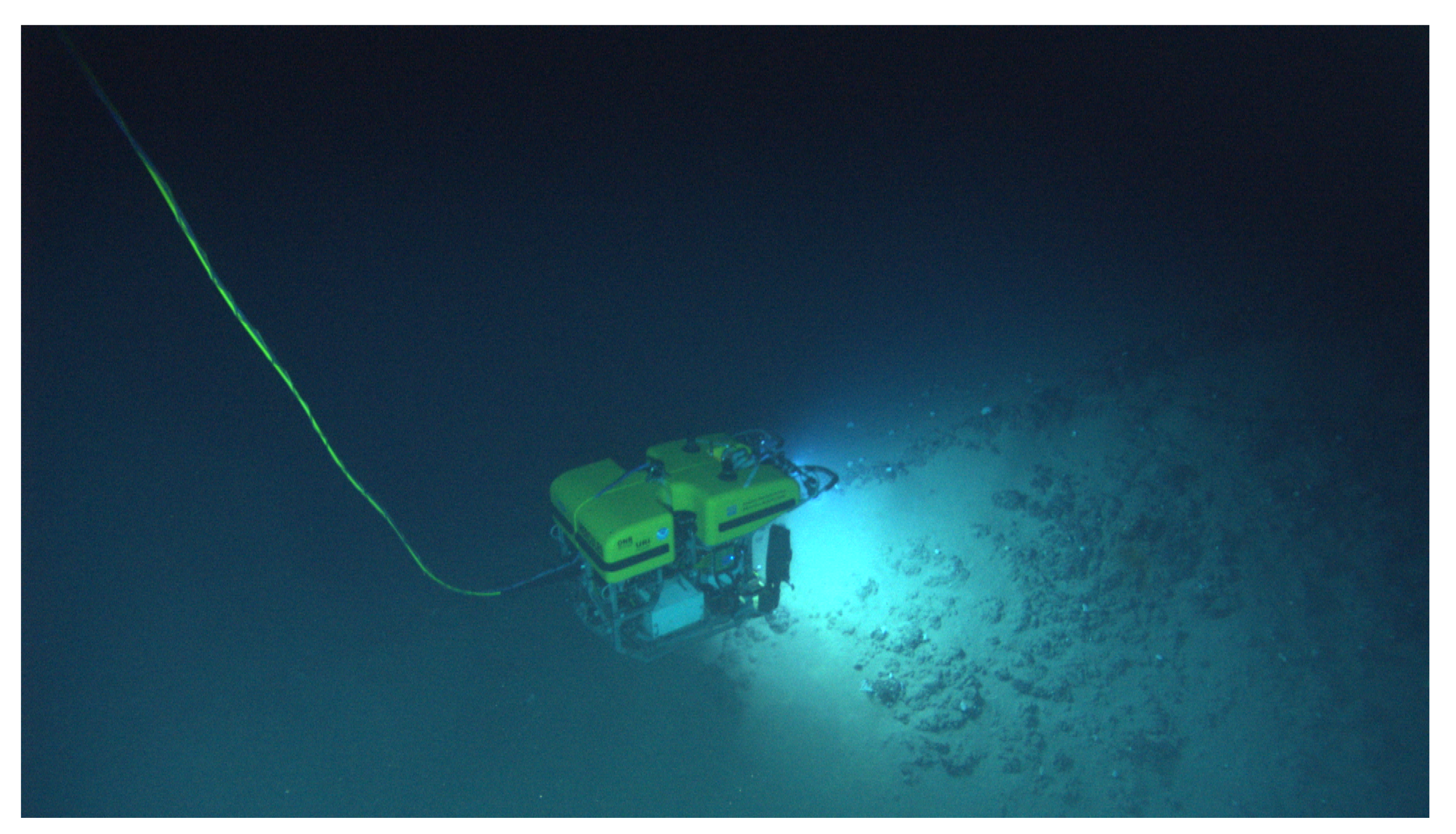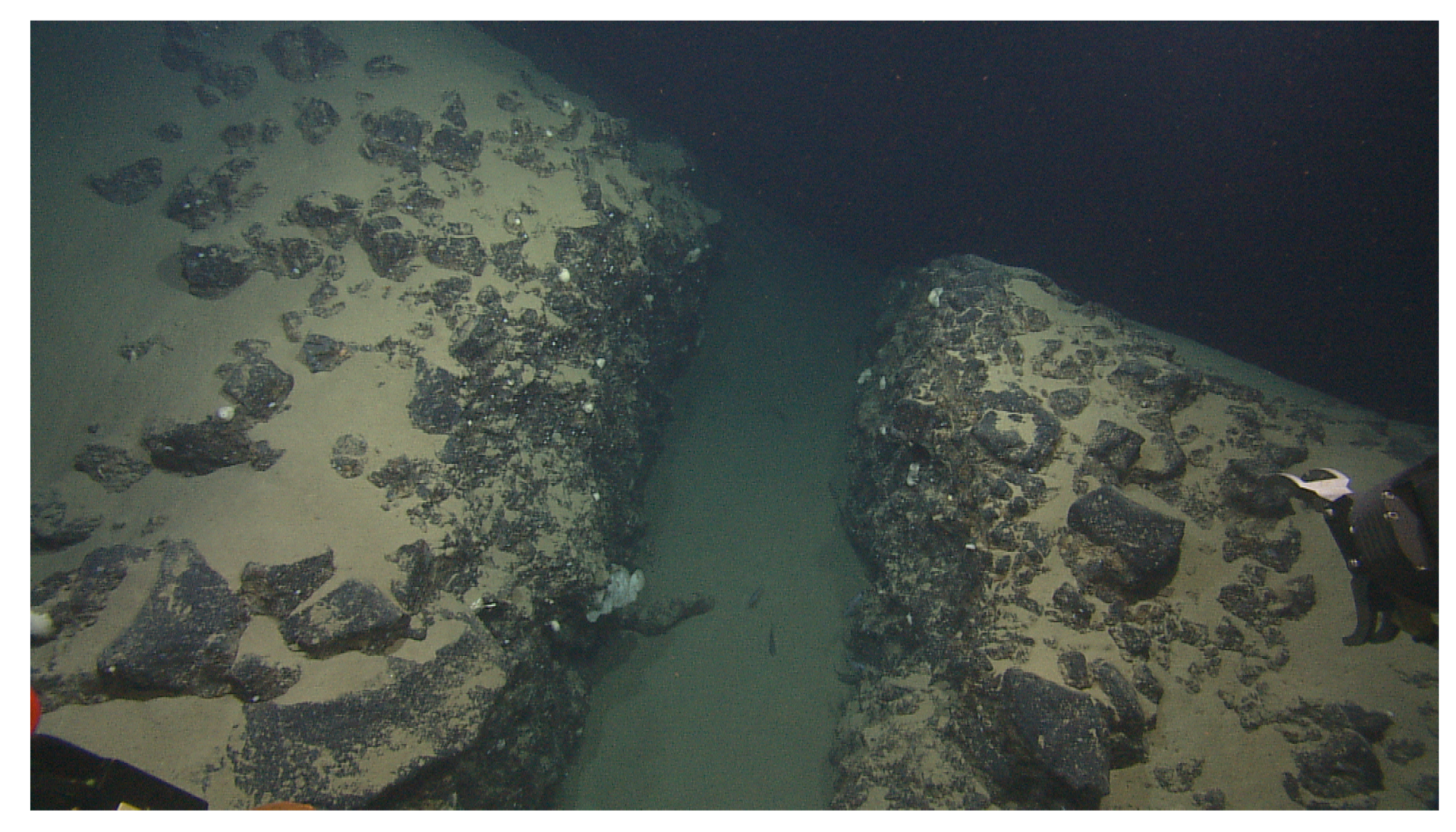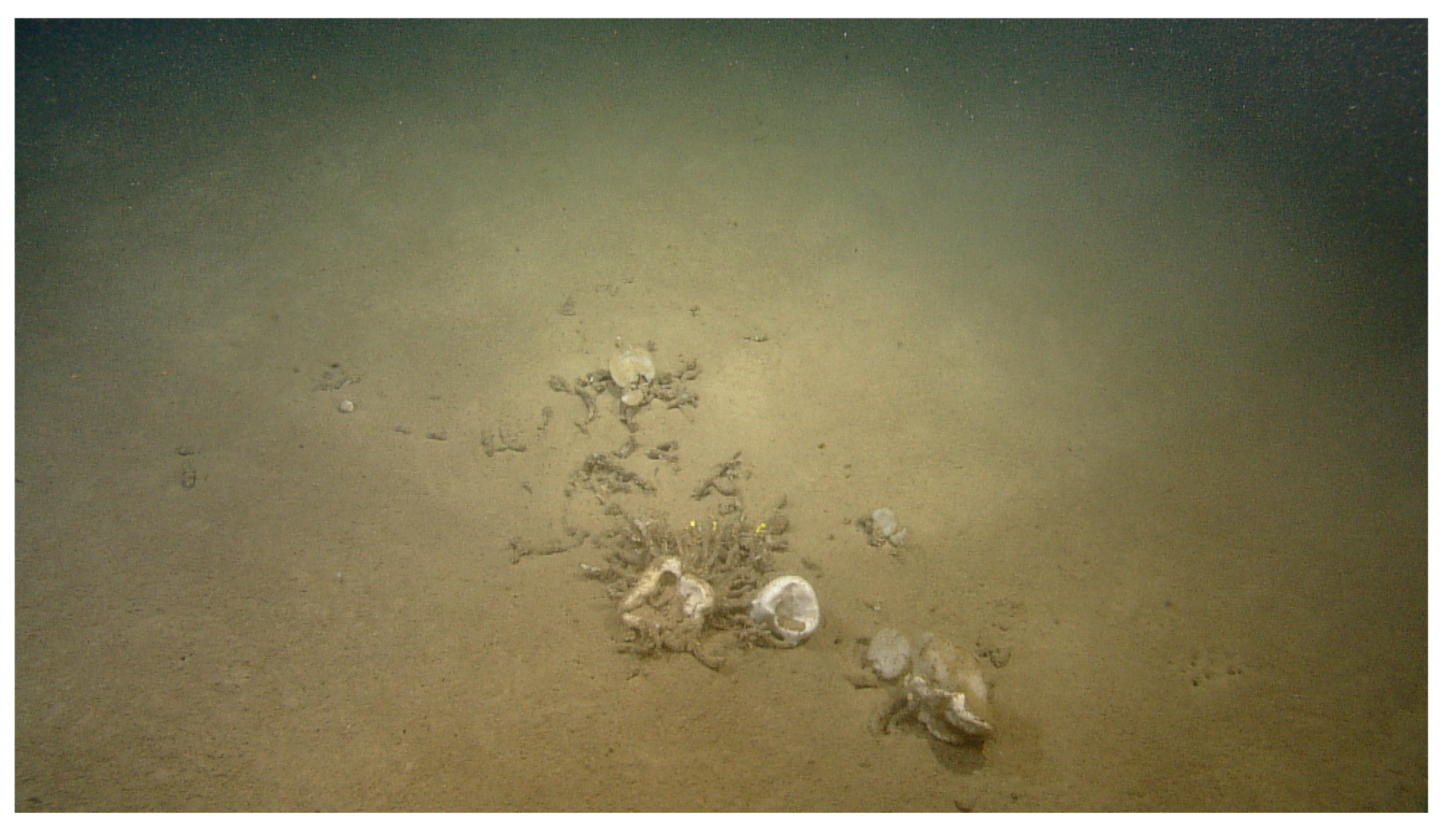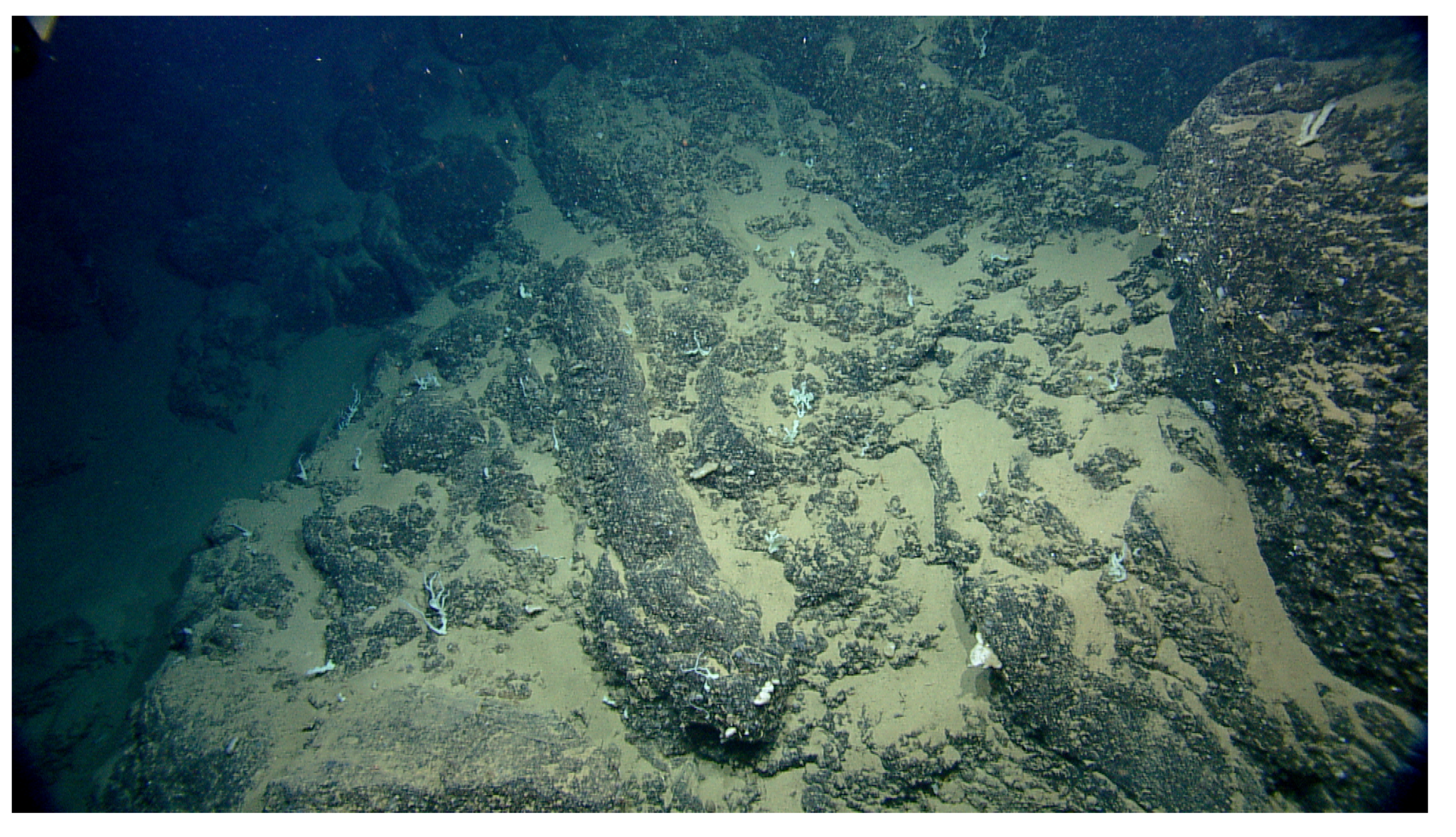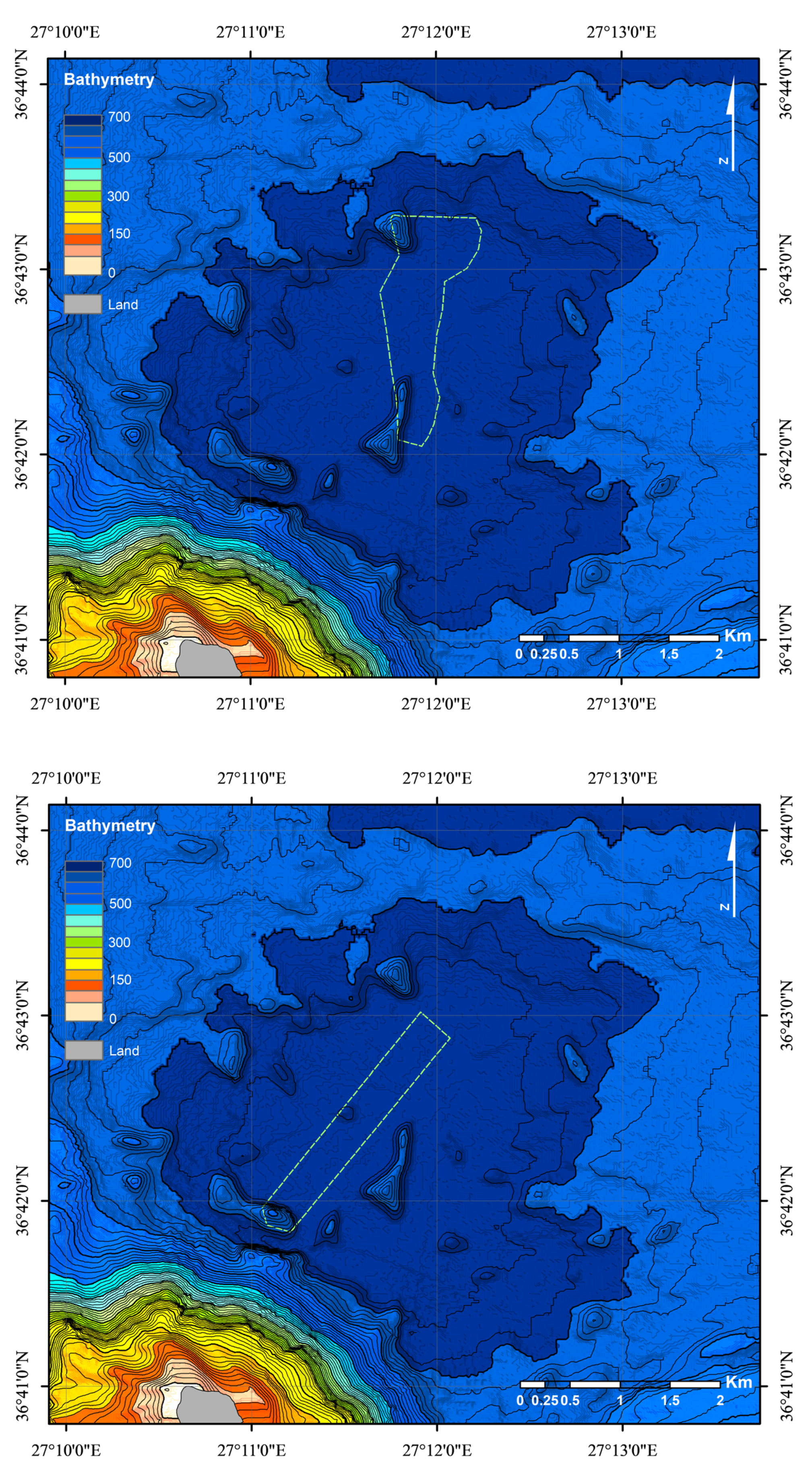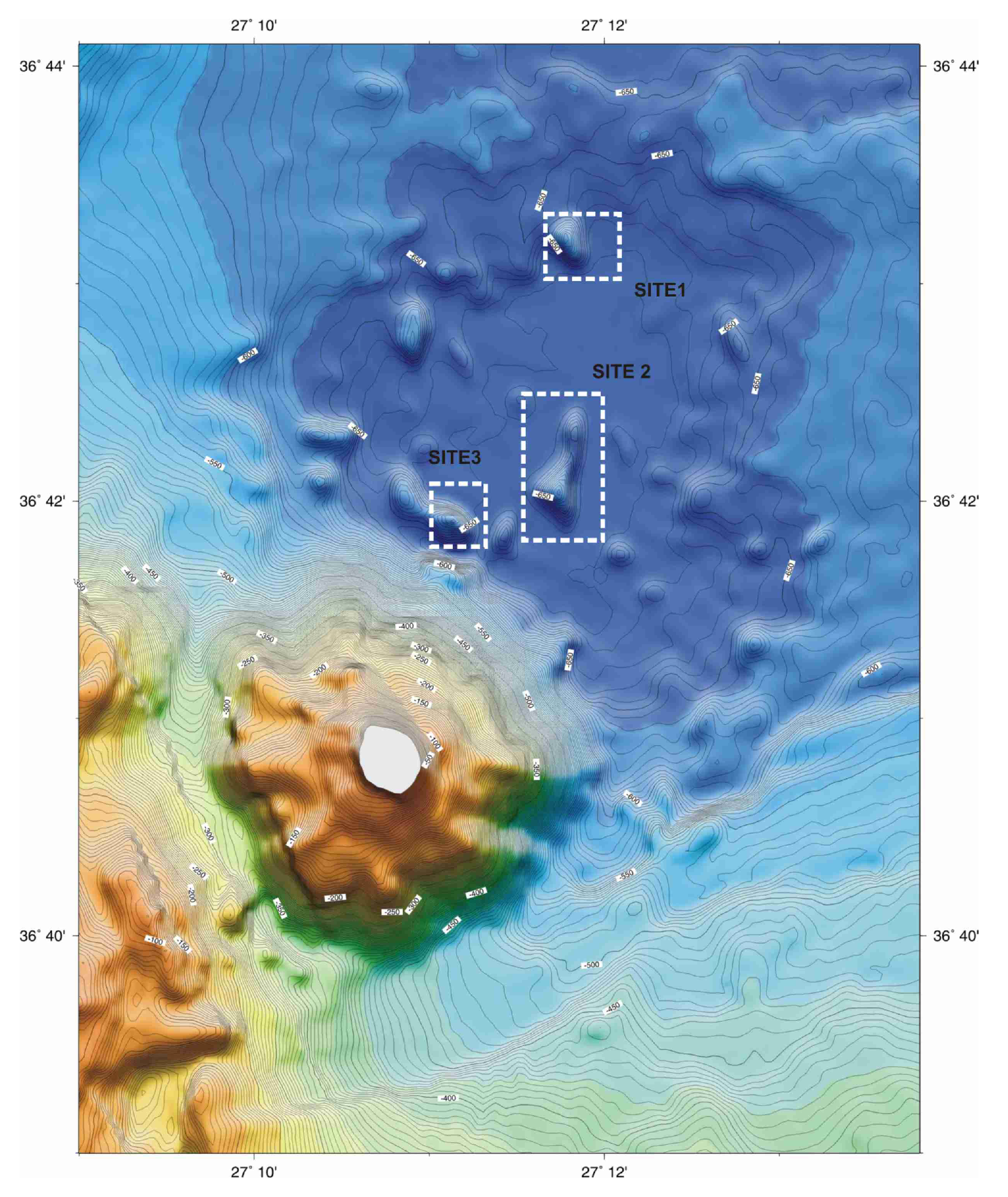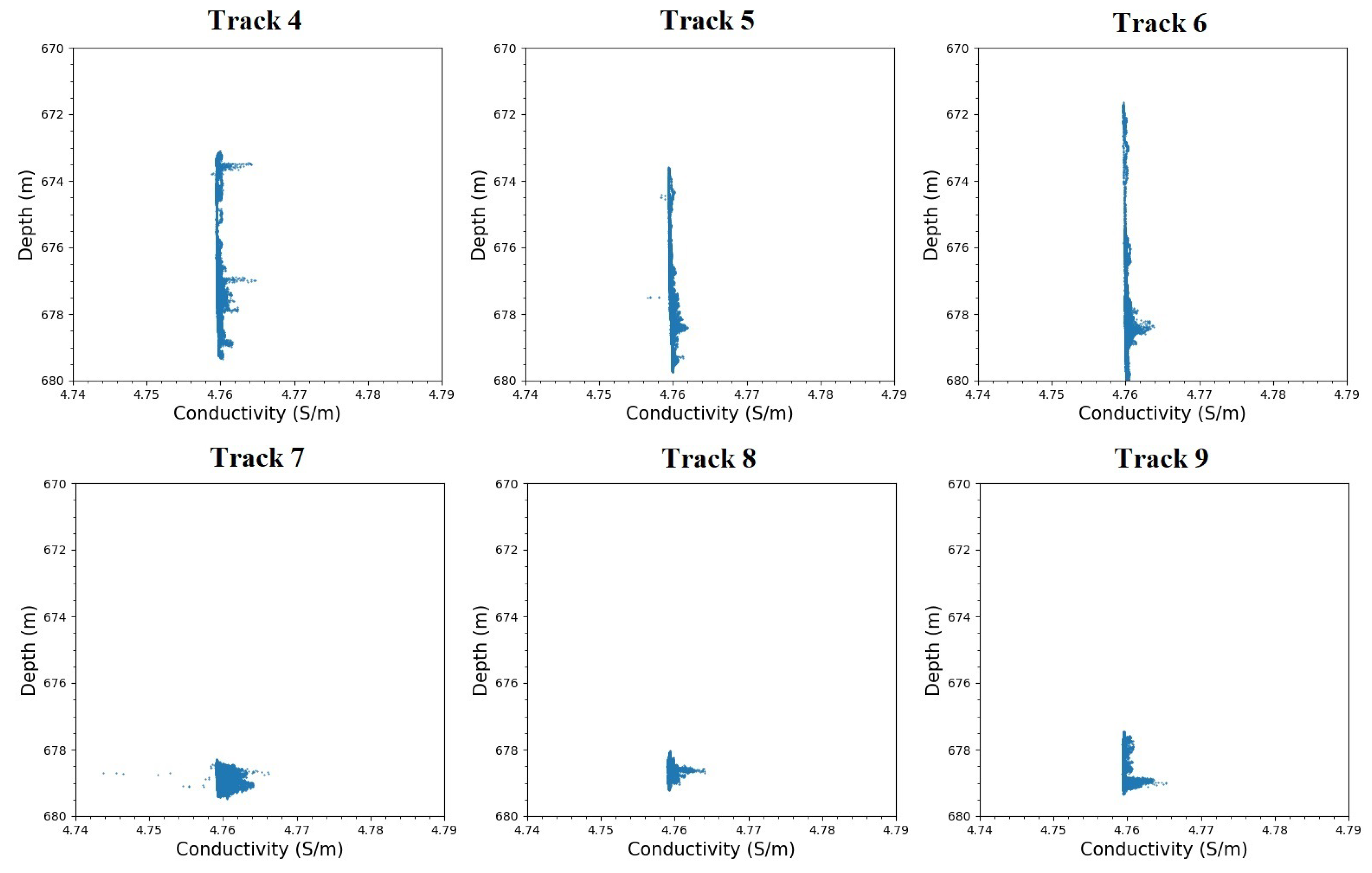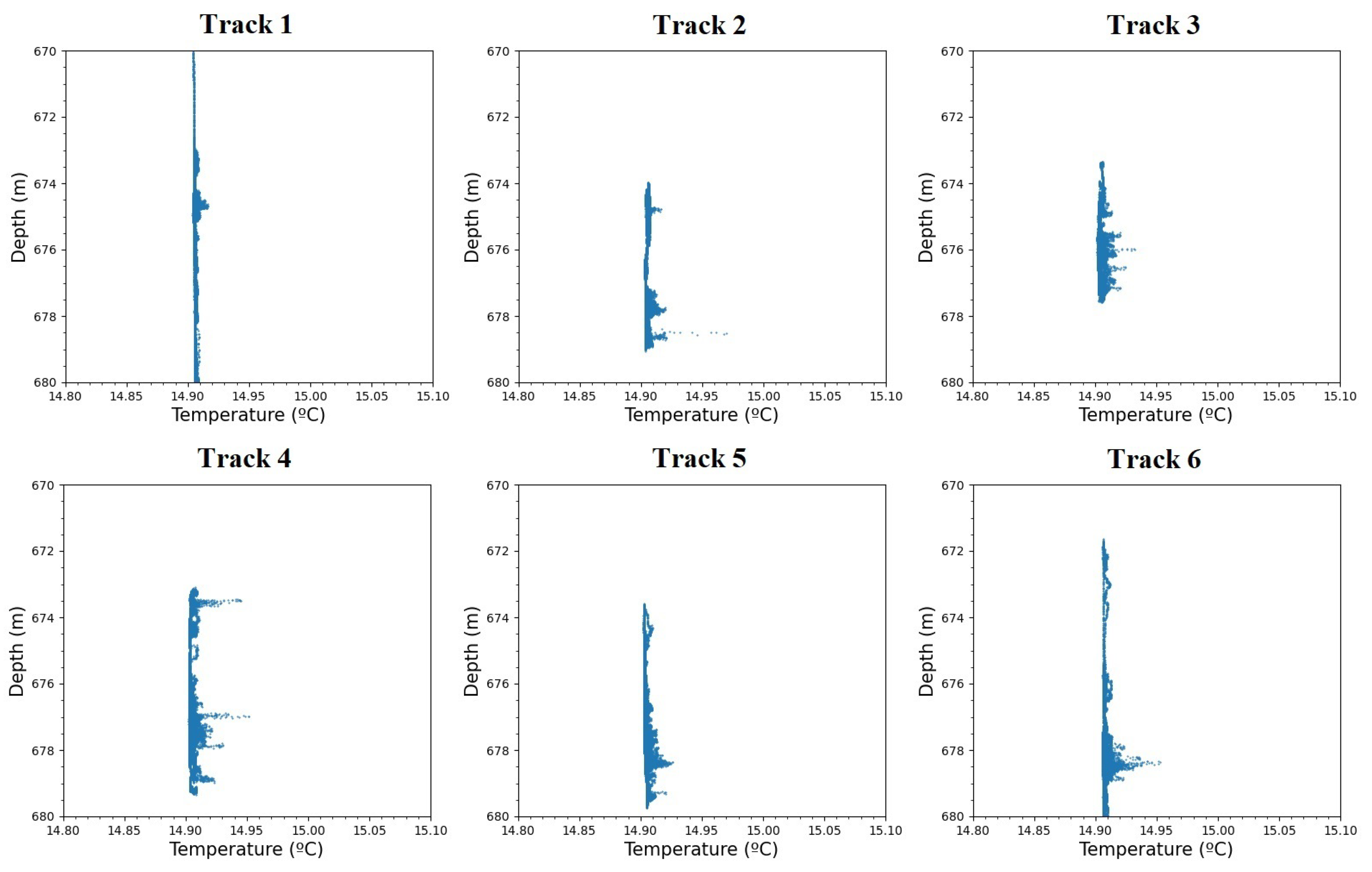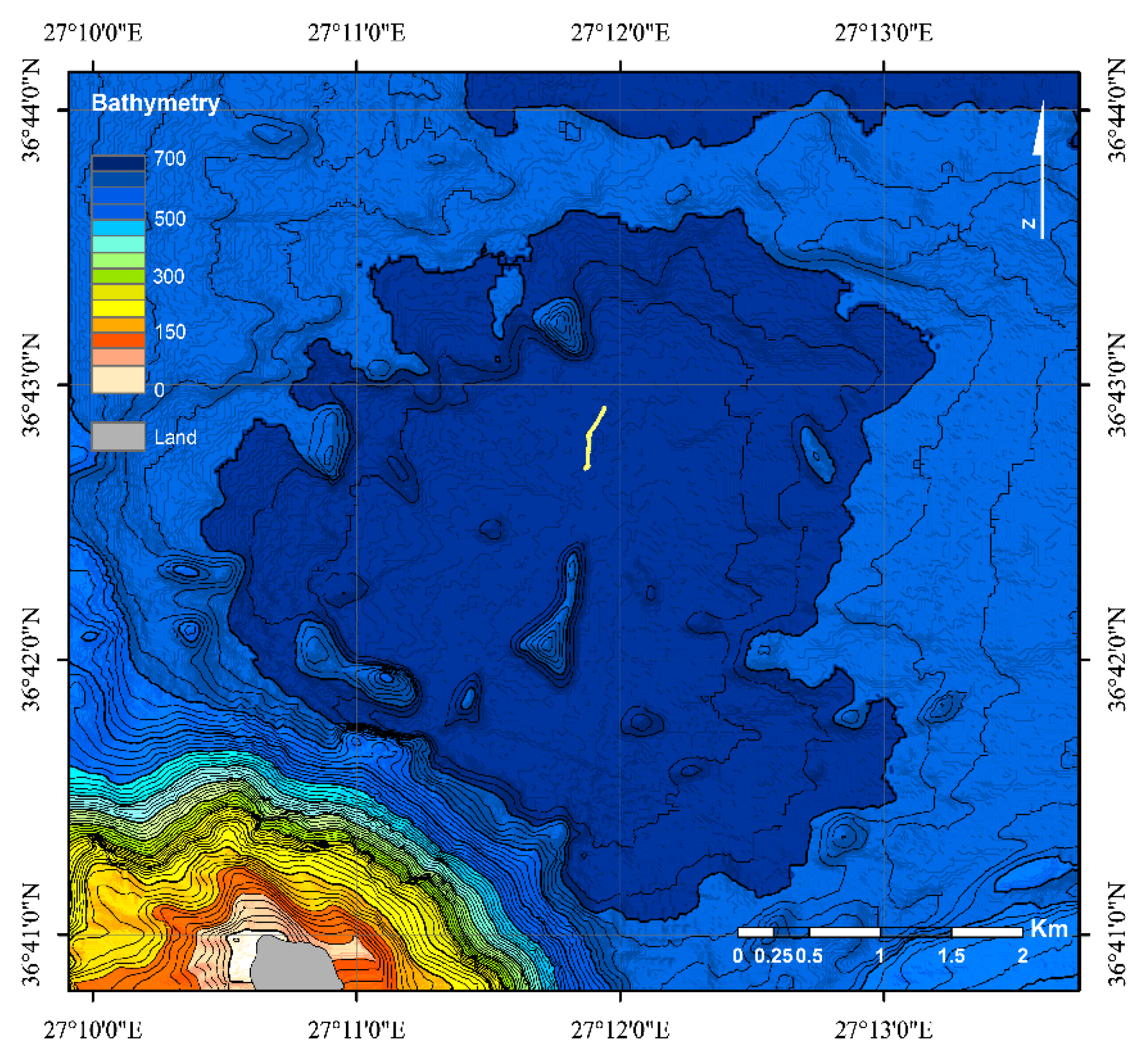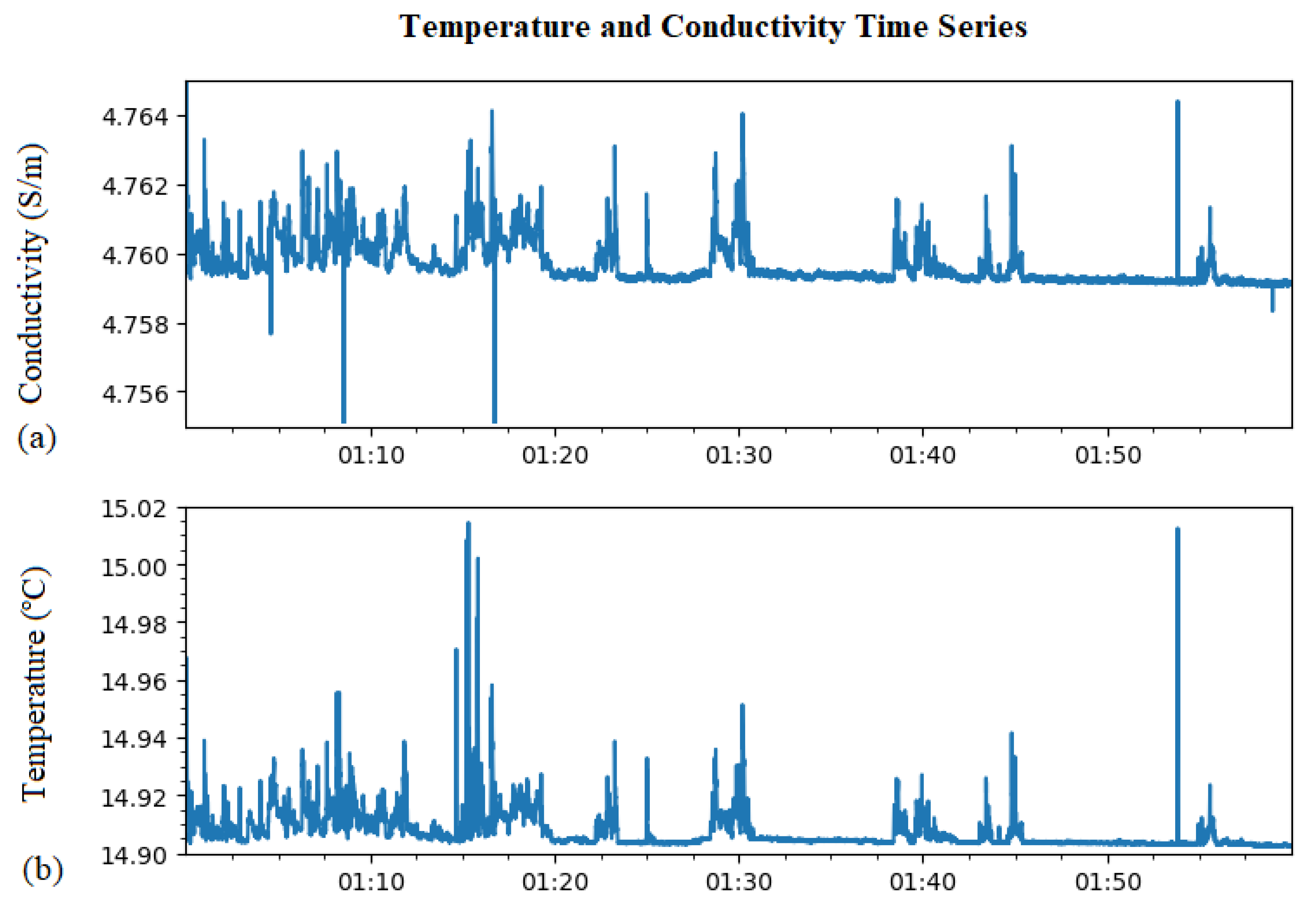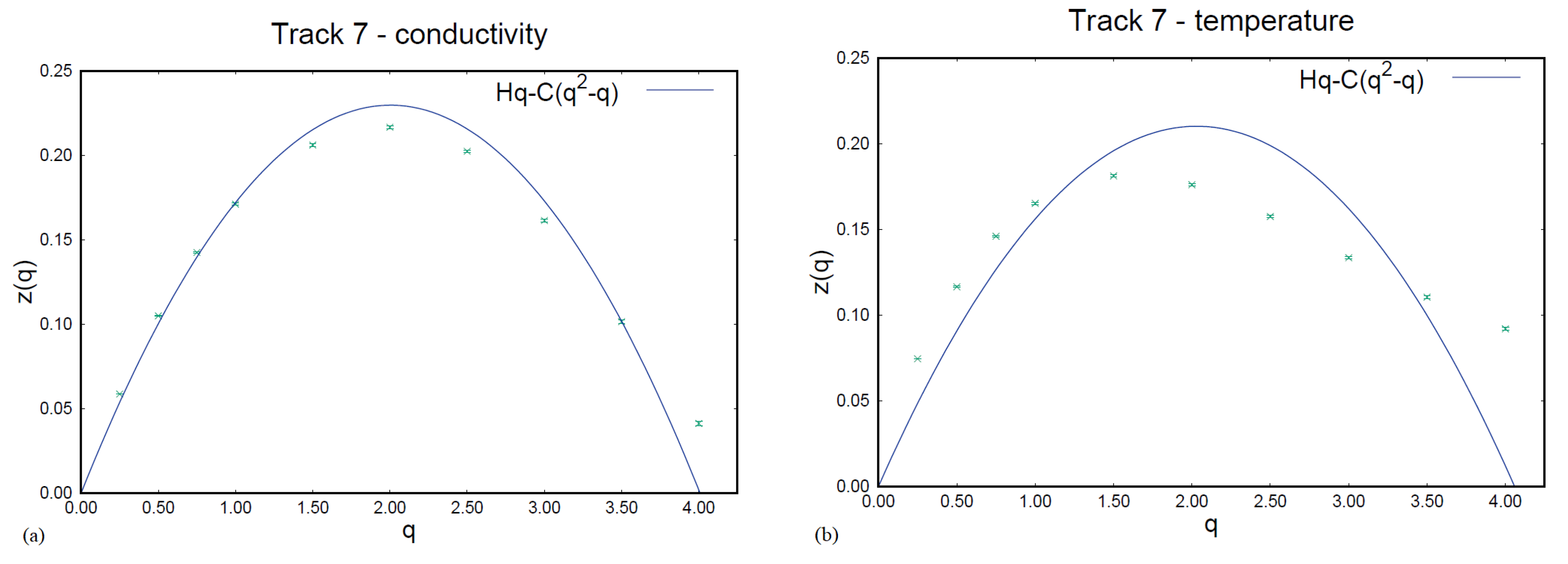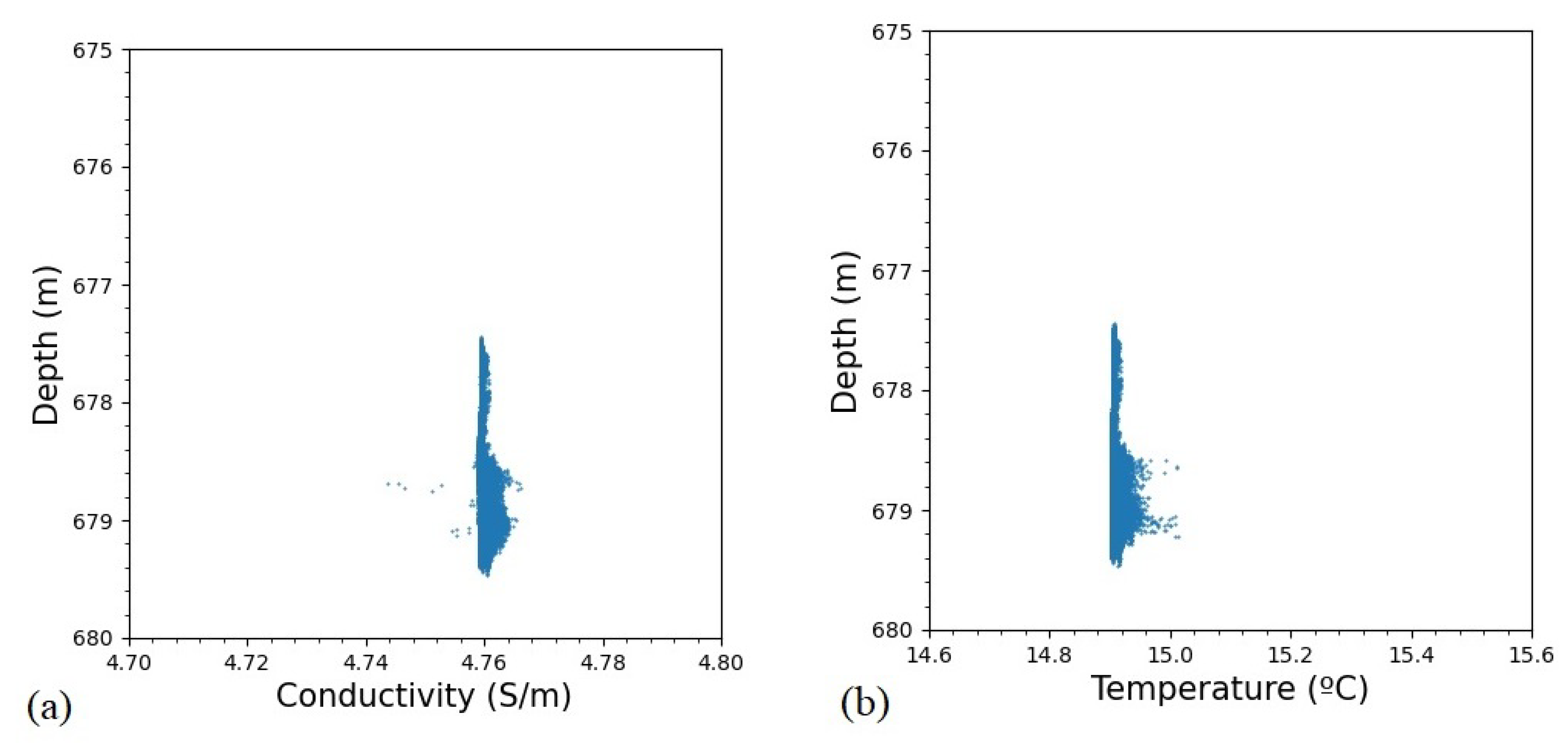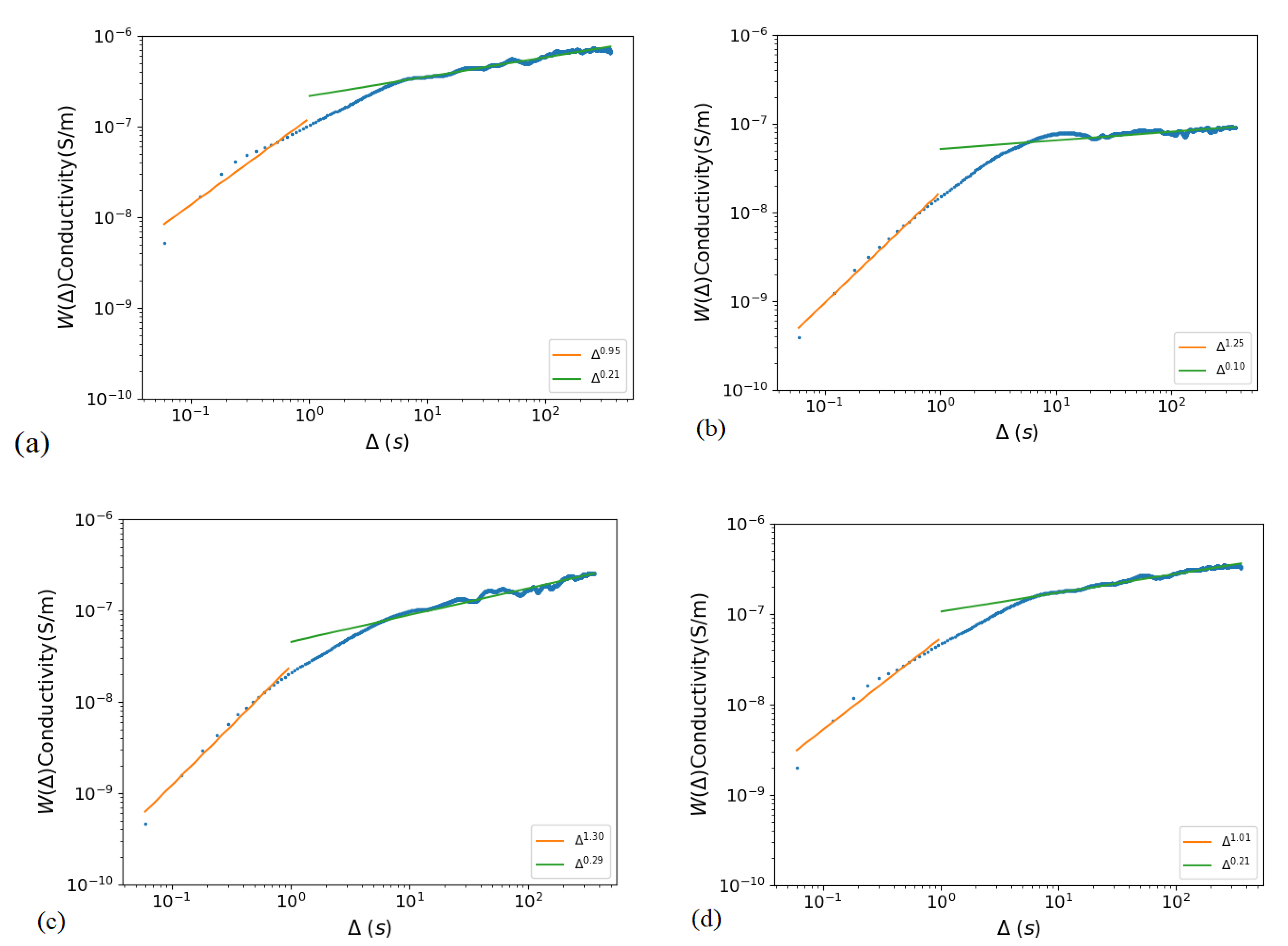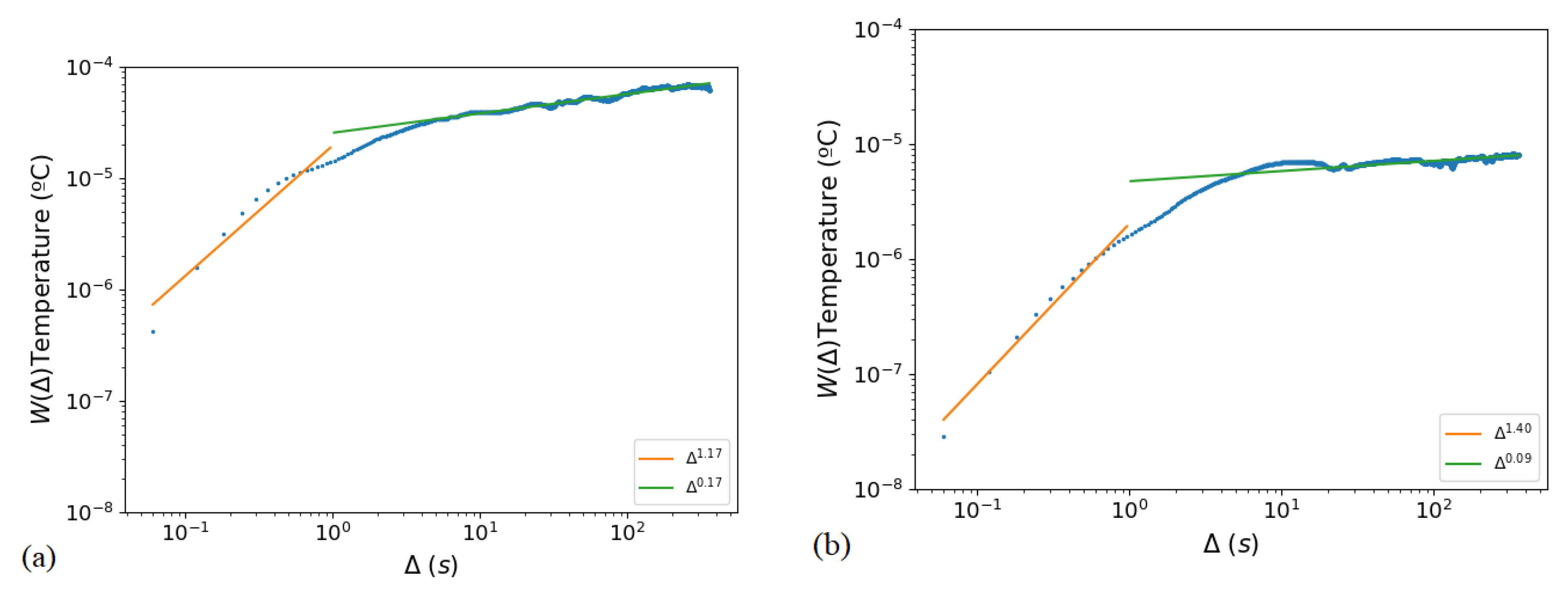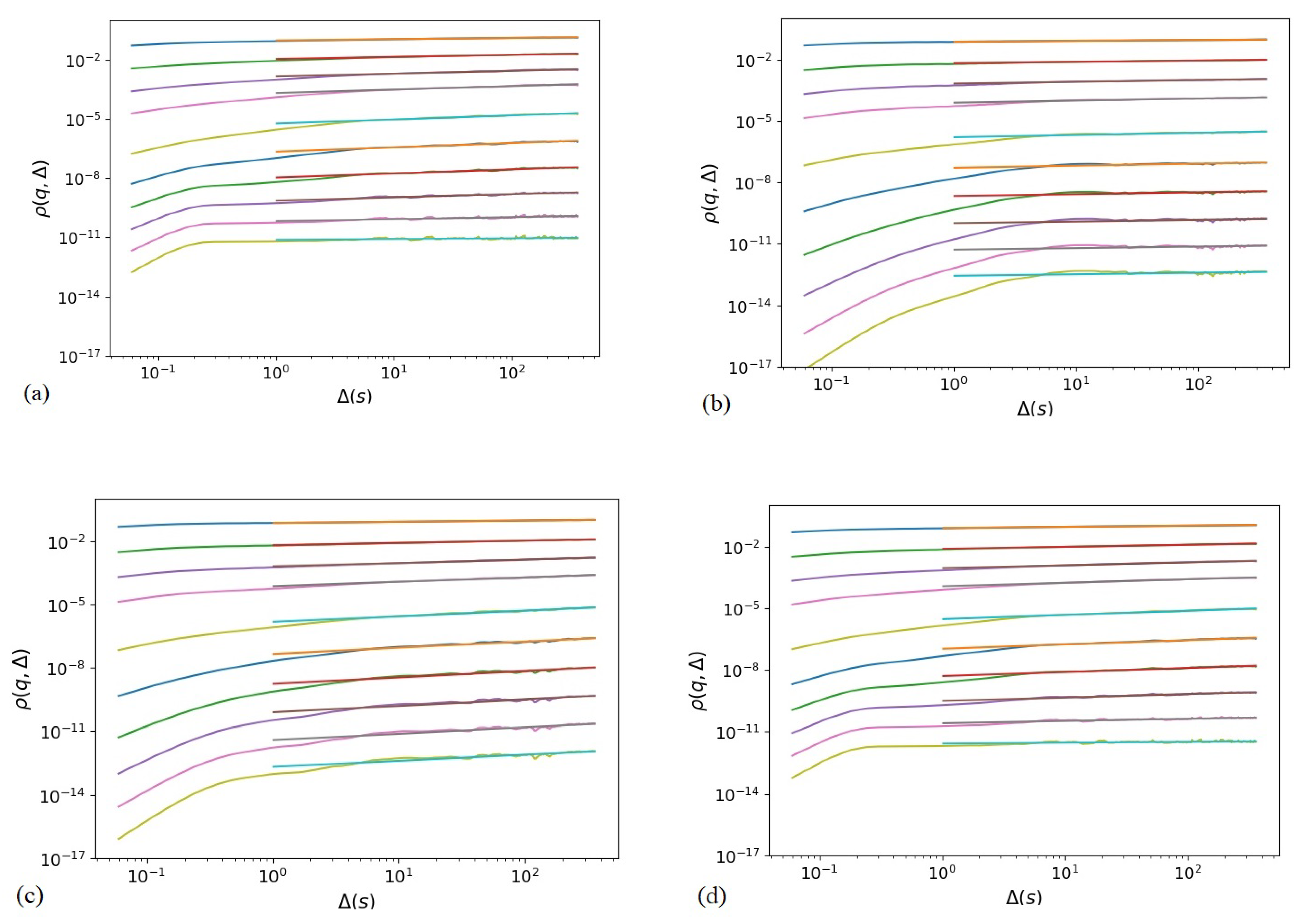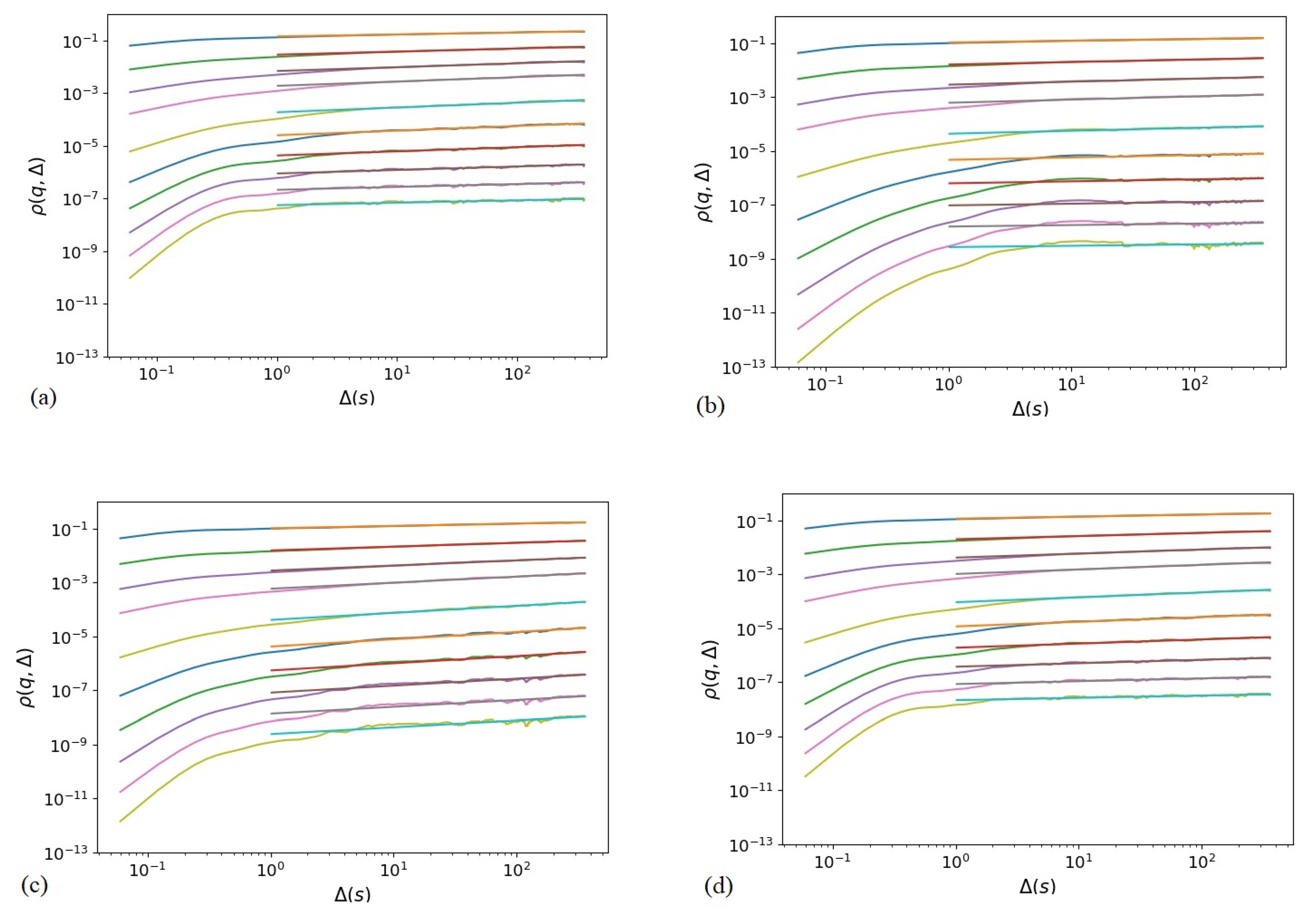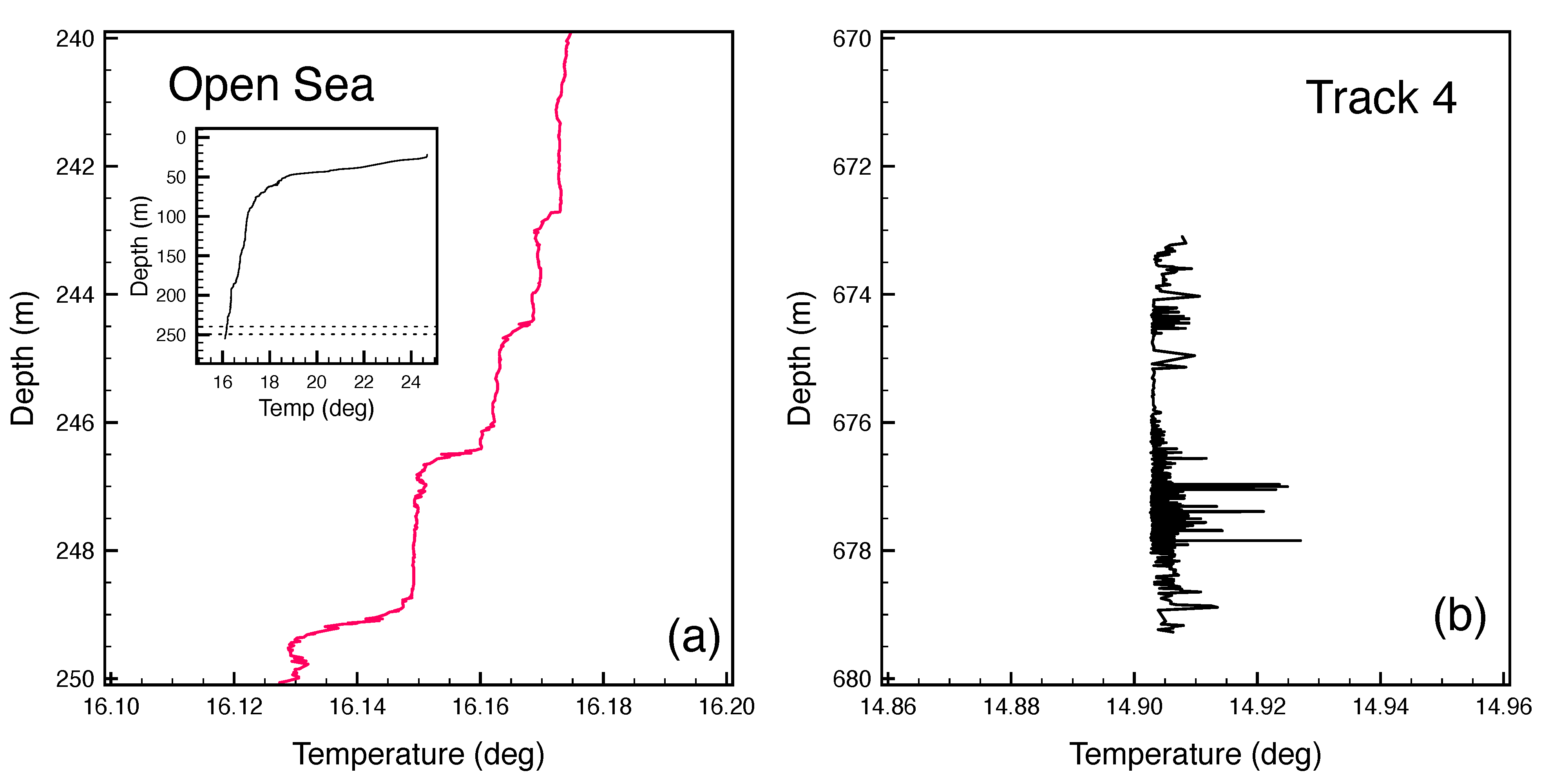1. Introduction
The Hellenic Volcanic Arc (HVA) resulted from the northward subduction of the African plate underneath the active margin of the European plate [
1,
2,
3,
4]. The HVA extends from volcanic centers of the Saronic Gulf in the west (W) to the Kos–Nisyros Complex in the east (E) [
5,
6].
The HVA volcanoes have been especially active in the Late Pleistocene–Holocene and occur onshore [
7,
8,
9] the peninsula of Methana and the islands of Poros, Milos, Santorini, Kos, and Nisyros [
10], as well as offshore [
6], with several submarine volcanoes detected in the Epidauros Basin in the W Saronikos Gulf [
11,
12,
13] NE of Santorini, the submerged Kolumbo Volcano [
14,
15,
16,
17], and in the submarine area around Nisyros [
18,
19,
20,
21,
22,
23,
24,
25,
26,
27] (
Figure 1).
Volcanism related to the modern South (S) Aegean volcanic arc in the Kos-Nisyros area began in Pliocene times [
10,
28]. Moreover, in Plio–Pleistocene times, lavas were emplaced on the centers of Pachia and Perigusa (a few km W of Nisyros) and in the lower succession of Nisyros [
29,
30,
31]. In Quaternary times, major magmatic activity in the area led to the eruption of the Kos Plateau Tuff, which covers an area of more than 3000 km
. The Plateau is thought to have been produced about 160 ka from a volcanic source located between Kos and Nisyros, with its center close to the young volcanic island of Yali [
30,
31,
32,
33,
34,
35,
36,
37]. According to Pe-Piper et al. [
38], the Kos Plateau Tuff was erupted from an original andesite stratocone, the remnants of which are present beneath Yali, Nisyros, and Pachia. The center of this eruption is not known with accuracy, but it is probably located in the submarine area, north of the Yali islet, a few kilometers NW of Nisyros [
21,
25].
The main onshore morphological features of the Kos-Nisyros-Tilos volcanic field are three zones of positive relief comprising Kos in the NW (843 m elevation in Mt. Dikeos), Nisyros (698 m in Mt. Prophitis Ilias) and surrounding islets in the middle, and Tilos (654 m, Prophitis Ilias) in the SE [
23,
24]. These zones divide the submarine area between Kos and Tilos into two basins with an average sea bottom depth of 600 m. Consequently, the topographic differences between the mountain ranges and the submarine basins are of the order of 1–1.5 km. This results in very steep slopes and a narrow zone of shallow depths (0–300 m) in the S coast of Kos Island. By contrast, the area of the islets around Nisyros is characterized by extended shallow water depths [
21,
26,
39] (
Figure 1).
Volcanism developed in the marine area around Nisyros with the formation of individual volcanic centers, each of them exhibiting a special geometry and evolutionary stage [
19,
21,
23,
24,
26]:
- (i)
The Nisyros Volcano, which is exclusively made of Quaternary volcanic rocks and has been characterized by a stratovolcanic cone, whose eruption created the Nisyros caldera. The largest present-day phreatic crater of Stephanos occurs within the Nisyros caldera along with other phreatic craters (such as Alexandros, Polyvotis, Phlegethon, and Achelous) that are still emitting fumaroles.
- (ii)
The Yali volcano, which exhibits a partly submerged caldera. The two parts of Yali are dislocated by a postcaldera N–S fault. Western Yali is made of two successive pumice formations, whereas Eastern Yali is made of obsidian glass covered by a pumice formation (equivalent to the upper pumice of the Western Yali).
- (iii)
The Strongyli volcanic cone, which starts at a −600 m depth (sea-bottom) and reaches +120 m at the top of the present day Strongyli Islet, where a 300 m-diameter volcanic crater is observed (pre-caldera stage).
- (iv)
The Pergousa volcanic cone, which is made of stratovolcano type formations, with alternating lava flows and pumice layers (pre-caldera stage).
- (v)
The volcanic domes of Pachia Islet and the submarine volcanic domes to the E of Kondeliousa Islet.
No volcanic activity is documented on the island for at least 25 ka after the formation of the volcanic domes of Prophitis Ilias; the only reported historical explosions are related to the formation of several phreatic craters inside the caldera. Violent earthquakes, gas detonations, steam blasts, and mudflows accompanied the most recent hydrothermal eruptions in 1871–1873 and 1887 AD (see the work in [
10] and references therein). During this activity some people were injured and minor damages were caused to the infrastructures.
The crustal seismicity of Nisyros exhibits the basic properties of active volcanic regions in quiescent periods [
40]. Nisyros’ seismicity has shown episodic unrest with local swarm-like earthquake sequences separated by months and years of quiescence. This is a characteristic which makes Nisyros comparable to other large calderas, such as Campi Flegrei (Naples, Italy), Rabaul (Papua, New Guinea), Yellowstone (WY, USA), and Long Valley (CA, USA) [
41]. At the end of 1995, the Nisyros volcanic region entered an episodic unrest period with long-lasting, highly clustered earthquake activity, which seems to be a characteristic of the region rather than a precursor of a volcanic eruption [
40].
From 1996 to 1998, the island experienced an episode of unrest that included a series of shallow earthquakes up to a M = 5.5 magnitude [
40], a considerable temperature increase in the hydrothermal system [
42], and ground deformation [
43]. Seismic activity related to the Mandraki fault caused significant damage on the island along the W edge of the town of Mandraki (located in NW Nisyros) [
26]. The fault extends N under the sea.
Despite its importance for risk assessment and mitigation, monitoring of the activity of submarine volcanoes is impeded by the remoteness and the extreme conditions of underwater volcanoes [
44,
45]. An efficient method to study those characteristics is to employ sensors aboard Remotely Operated underwater Vehicles (ROV), able to record CTD data (Conductivity, Temperature, Depth) in the water column (see, e.g., in [
46]). Previous studies of the underwater features around Nisyros have focused on the geomorphology, using ROV to collect data, and have explored the volcanic field offshore, mainly in the Nisyros-Yali-Strongyli area [
26].
Such data were collected for the first time in the underwater caldera Avyssos at the NE part of the volcanic islet of Strongyli, N of Nisyros volcano (
Figure 2). The size of Avyssos caldera stretches for 3 km and 4 km along NW-SE and NE-SW directions, respectively, with a maximum depth of 680 m [
23,
24]. In addition, there is an underwater hill, about 1 km long at the center of Avyssos with a positive relief of about 60–70 m above a flat sea bottom. A dedicated mission conducted in 2010 focused on exploring the unknown volcano-tectonic characteristics of the Nisyros-Yali-Kos region and the associated volcanic field around Nisyros [
26]. The main focuses of that mission included the observation of the previously unexplored hydrothermal field of Avyssos. In the present work, results from the full investigation are reported for the first time in terms of high-frequency CTD measurements using sensors mounted on a ROV (
Figure 3).
A small portion of the full data set has been reported and analyzed by our group in [
47] using a novel mathematical method, based on the Generalized Moments Method (GMM) [
48]. The same modeling method had been successfully applied to identify the underlying stochastic processes driving the activity of the Kolumbo volcano in the Aegean sea [
49]. This study yielded interesting aspects of the underlying dynamics of Kolumbo’s hydrothermal vent field during rest and unrest periods.
Due to the non-zero probability of eruption, and thus of its potentially devastating effects on the environment, society, and economy, the dynamic state of Avyssos is studied utilizing the data collected in October 2010, significantly extending our initial work in 2018, as reported in [
47], to the full hydrothermal vent field in Avyssos.
4. Discussion
In the present work, vertical CTD profiles are presented for the first time with a full range of temperature and conductivity time series from the submarine caldera of Nisyros. The hydrothermal vent activity is relatively low and cannot be seen in the visual images captured by the cameras on board the ROV, as opposed to analogous findings from the Kolumbo submarine volcano that same year, where the activity was evident and the cameras captured ongoing plumes [
15,
17]. In 2010, Kolumbo underwent a period of unrest (Kolumbo2010), while in 2011, it was at rest (Kolumbo2011) [
49]. These findings make it clear that hydrothermal venting occurs in different ways across periods of different activity. Understanding the data patterns as well as the underlying mechanisms stresses the importance of monitoring submarine volcanoes.
Comparing the data between the periods of rest and unrest within Kolumbo with our findings in Track 7 (Avyssos2010), we see that our results differ from both cases in Kolumbo. In
Table 7, we compare the values of
H and
C from Avyssos2010 to the data published in Bakalis et al., 2017 (Kolumbo2010, Kolumbo2011). Note that all tracks presented in the table had a time-span of an hour and the missions in Kolumbo and Nisyros shared the exact same equipment and survey methodology; as such, they can be confidently used to distinguish different states of unrest in their hydrothermal vent fields. Kolumbo is considered to be one of the most dangerous submarine volcanoes in the Mediterranean [
59]. Our results in Avyssos2010 differ from the results in Kolumbo in a way that makes it of lesser risk than Kolumbo2010, but also more prominently active than Kolumbo2011. During the resting period of Kolumbo, the values of temperature parameters are null, which is not the case in Avyssos.
On the other hand, the variance vs. lag time graph appears to have three regimes for conductivity in the data from both Kolumbo2010 and Kolumbo2011, while in Avyssos2010, we only have two regimes. Temperature in Kolumbo2010 has three regimes as well, while in Kolumbo2011, temperature variance is parallel to the time axis, which results in a
exponent equivalent to zero. In Avyssos2010, no parameters are null. The morphological structure of the two volcanoes are different, which might result in the difference in behavior after a time period, thus creating three regimes for Kolumbo and two regimes for Avyssos. The two submarine volcanoes differ in shape and size as Kolumbo has a circular cone with abrupt steep slopes, while Avyssos is a 3 km wide volcano [
6].These geomorphological characteristics make Kolumbo a closed thermodynamic system, and Nisyros an open one. However, the thermodynamic state cannot account for the null values of temperature parameters during the resting period of Kolumbo, considering the homogeneity of hydrothermal fluid outflow.
The statistical moments in Kolumbo2010 appear to have two distinct regimes in the moments vs. lag time graph, with a turning point at s. In Kolumbo2011 however, the turning point is at s, the same as in Avyssos2010. This can be interpreted as an indicator for similar dynamics to Kolumbo2011 despite some structural differences in the variance function.
Last, the structure function has a convex shape in Kolumbo2010 and in Avyssos2010. As for Kolumbo 2011, the structure function of conductivity appears to have a similar behavior, whereas for temperature, is 0 for all values of q.
Regarding the time series in Avyssos, the first results from the survey [
47] originate from a simple data set gathered in 10 October 2010, during a total recording time interval of 1 h and 30 min. That time series preceded the data in the present work and were recorded over a specific location while the ROV was slowly hovering. According to those results, when the volcano is at rest, conductivity seems to obey a stationary process, and the crater of the volcano is in direct contact with the overlying water environment, thus defining an open system. In this research, the same methodology was used to extend the analysis of the entire data set gathered from the deepest parts of the caldera (10 and 11 October), covering approximately the full area under investigation.
We consider anomalies in the time series to be spikes that deviate from the baseline. The baseline in the case of Track 7 (
Figure 13) would be a line almost parallel to the time axis at about 4.756 S/m for conductivity and at approximately 14.91
C for temperature. Both parameters would be otherwise stationary and would evolve in time in a manner that would prove irrelevant to a baseline, where there no activity (as is the case for Kolumbo2011). We use these values as a reference to evaluate the anomalies. For conductivity, the most prominent spike diverges at
from the reference baseline, while for temperature, the respective percentage is
. The above observations are similar for all tracks presented in here (such as Track No 4, etc.). In Kolumbo2010, conductivity spikes scale at a maximum of
(spike = 5.5 mS/m, baseline = 4.2 mS/m), while temperature anomalies spike at
(spike = 21
C, baseline = 16.2
C), which shows the near-explosive state of the volcano. The case of Avyssos2010 clearly differs to the case of Kolumbo2010. Conductivity and temperature parameters in Avyssos2010 spike at a much smaller scale in terms of absolute values, as well as percentage, compared to Kolumbo2010. In Kolumbo2011, spikes appear to be random and constant with no particular baseline to reference any anomalies (see Figure 1c,d in [
49]).
Activity is evident in both time series and vertical profiles, and seems to be consistent among conductivity and temperature, which are the main points of focus. The time scale peaks appear at the exact same point in time (
Figure 13), whereas the vertical profiles appear at a similar depth for both the parameters (
Figure 9 and
Figure 10). In the case of the vertical profiles in Track 7, we notice spikes that skew at
for conductivity and
for temperature, respectively.
An additional piece of evidence is the comparison of the present vertical CTD profiles with reference CTD data. As such, a vertical profile between 20 and 250 m recorded with the exact same methodology and instruments during the same mission (but earlier time) in an open sea location, where no hydrothermal activity exists, has been considered and is shown in
Figure 21a. The inset shows the full CTD profile, while the main panel shows a magnified region with the same x- and y-axis ranges as with
Figure 21b which shows Track No 4 for comparison (see also the caption of the figure for further comments). From this comparison, it becomes evident that the vertical CTD profiles in Avyssos differ completely from respective (“reference”) CTD profiles in open sea, where effects such as mixing, thermal layers, turbulence, etc. can affect their shape. In this case, no abrupt changes are observed, rather step-like changes occur at certain depths. The situation can be easily generalized by comparing the open-sea vertical profile with any one shown in
Figure 10.
Despite the activity of the volcanic field in Avyssos being weak and almost homogeneous in its entirety, as shown in the overall ROV surveys, the values of the exponents
are scattered for both conductivity and temperature in the first regime (
Table 2 and
Table 3). On the one hand, conductivity shows a normal to a slightly super-normal behavior, with the only exception in Track 1, where points are either uncorrelated or display persistent trends during reduced time intervals. On the other hand, the scaling of all tracks for the temperature indicates persistence. In the second regime, both fields present a strong anti-persistent motion, which mirrors on their slow changes.
These values reflect the existence of an active vent field, the behavior of which is not persistent. In addition, the value of the Hurst exponent indicates some delay between two similar value pairs in a time series. This situation reveals the existence of weak, homogeneous sources of hydrothermal fluid outflows, which are found throughout the entire examined area.
The exponents of
appear to have similar behaviors across various locations inside the caldera, as well as among conductivity and temperature. The similarity in behavior across parameters is also verified in their time series and their profiles. In
Appendix A, the full list of maps, CTD profiles, and CTD time series for all Tracks mentioned in
Table 1 are presented for Avyssos.
The analysis of the recorded time series of temperature and conductivity just above the Avyssos submarine volcano shows that both parameters seem to present an initial multiplicative behavior reflecting the mixing of at least two different random processes, which then turn to be quasi-stationary.
In the case of non-persistent hydrothermal activity, we expect to find dissimilar results when analyzing data from a longer period of time while the ROV remained at the deepest locations possible. As the analysis was performed while the ROV was hovering and slowly moving over a wider area at the same time, a direct comparison with the previous work in Nisyros [
47] cannot be made. This seems to be distinctly reflected on the behavior of the conductivity time series, which have been found to be completely different from the single time series reported in [
47]. The conductivity time series reported here present similarities with the temperature time series, which is not the case in the earlier work reporting results over a specific location in the vent field.
Comparing the results of the hourly intervals to the total of three hours (Tracks 7, 8, and 9), we find differences in the behavior of the moments . These differences are possibly attributed to a number of factors. One factor may be the particular geomorphological features of the caldera along these tracks, as the caldera bottom is not smooth. In addition to that, the ROV hovered over the seafloor in a slow motion, instead of being absolutely still. Finally, the weak variations in the underlying hydrothermal activity across the caldera can also potentially lead to these differences.
Although generally considered inactive, the island of Nisyros exhibits the basic properties of active volcanic regions in quiescent periods [
40]. From time to time, a period that may range from months to years [
40], Nisyros enters a period of unrest which leads to seismic activity, significant temperature increase in the hydrothermal system, gas detonations, steam blasts, mudflows and ground deformation [
42,
43,
60,
61,
62,
63,
64,
65]. The possibility of Nisyros entering the next periodic unrest in a few years cannot be fully excluded as suggested by the existence of weak hydrothermal sources found within the caldera.
Moreover, the present work confirms that the application of the GMM in geosciences seems to find a clear-cut way, at least in terms of analyzing CTD time series, to investigate the underlying mechanisms governing the activity of hydrothermal vent fields in submarine volcanic areas. As the GMM has been used in econometrics, commercial packages offering GMM analysis tools in geosciences are still not widely available, to the best of our knowledge. Based on our experience working with GMM to analyze CTD time series, we argue that such computer codes could significantly reduce the time needed to reach conclusions, something particularly useful for cases where the risk of natural hazards should be assessed and mitigated promptly. It is clear that monitoring natural hazards associated to submarine hydrothermal vent fields with state-of-the-art instrumentation is the spear to mitigate those risks. However, the continuous increase of computing power facilitates the introduction of advanced tools, such as Artificial Intelligence and Machine Learning, and can offer the chance to statistical methods, such as the GMM, to play an enhanced role as a complementary approach. An additional advantage seen in the present research is that the combination of a mathematical model (GMM) with fast, state-of-the-art sensors (ROV-based CTD) that collect data can provide a framework for understanding dynamic processes in the marine environment that could completely remain unknown by using traditional techniques of exploration (such as visual inspection or use of samplers).

